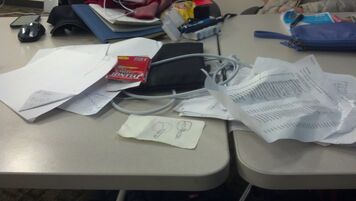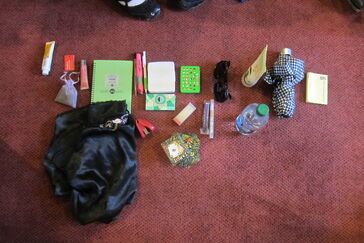
What's in my bag, made it purposely messy to match my actual bag
This is the method where we look at people's stuff and try to connect them, to see what is important to them and why, as well as what is the items history, or genealogy.
This nature of this object is artifact analysis, trying to get insights based off objects.
The nature of this method is artifact analysis and research, since you are researching it through artifact analysis. The context that you will use this method is if you want to see how all the items someone has connects with each other.
Description of the Method[]
Basic description
"Personal inventories allow the designer to see and understand the relevance of objects in a
user’s life from the participant’s point of view, to inspire design themes and insight"- Martin and Hanington, Universal Methods of design
In this method, you try to connect peoples possessions together to try to understand them better as a whole, and seeing what is important to them.
For this project, we did it by asking people to empty there bags, so we can learn more about them through that, but it does not have to be with just emptying a bag, it could be anything. But for the "Actually Doing the method" section, I will focus on the bag example.
The key things to look at is
- Genealogy: the history of the object, what the object means to them, what it is made out of, why they have it, etc
- Landscape: How does each object fit in with each other. Does some objects conflict with each other? Do some go well together? Do some have to go together in order to work? What is missing from this area that you expected to see? Where is all the stuff located? Etc.
Actually Doing the method
First you have to find a person to do this method on, and you should base it what you are trying to learn. Before you go in to do the method, you should make sure you have a way to record what your doing. This could be a notebook, camera, video camera, audio recorder, etc. You should at least have a camera though, since pictures are really important with any artifact analysis.
Once you have found a test subject and they have shown you there stuff, you should lay out the items in a way that is meaningful, to get a better feel about it. You can then look at all the items individually and in the grander scheme of things. You should also ask questions about them, and try to learn as much as you can. If possible, get the persons number or email so you can get back to them if needed.
Afterwards, you can go and try to connect the items that you just saw, and build insights off of it. Try to figure out why this person has all these items, what is important to them, what do they use a lot and what do they not, etc. Also look at what is missing as well. Sometimes those can be the most interesting things, what you expected to be in there and is not.
Positives and negatives[]
Positives
- Allows you to see a persons extended self with the items in there bags
- Shows you whats really important to them, since they carry it where ever they go
- Allows you to make connections about certain items.
- Allows you to learn a lot about that one person.
- Is a really interesting method.
Negatives
- Does not seem very useful in the long run, Like I honestly cant think of a situation where this will be that useful.
Tips and Tricks[]
- Really examine each object to see all the pieces of it, and dont be afraid to ask questions
- Ask about all the objects you find interesting, so you can get more information on it.
- Dont just look at what is there, look at what is not there that surprises you.
- Look for things you find odd, such as two different things that do the same purpose, and act on those.
- Try to figure out why this person has all these items with them.
Project we used it for[]

Bag from project
For this project, we found a person and had her dump her bag out, and she was actually very okay with doing this. Her friends were actually the ones that were kind of against it, and were worried about it. After this, we organized the stuff in her bag, and went straight to asking questions about the two objects we had to talk about. I think this was a mistake on our part, since we basically skipped over all the other objects in the bag because of this. Like I personally think interviews are amazing, because you usually find out double the information, and I wish we could have asked her about some of the connections we were already making with her bag of stuff.
Actually, out of all of the projects, I feel like this one had the most "oh we should have done this" moments. For instance, we one of the items we did was a journal, and as I was doing the write up I realized we never opened the journal to see how far she wrote out. We didn't open it to respect her privacy, but now I see that we probably should have at least tried. I
Which I guess is a good learning experience, but it kind of stinks at the time. We also probably should have gotten the persons number, even though I doubt she really wanted to continue talking to us.
Hughes's Corner[]
This method I was a bit confused about, and still do not know how I would use it in the real world. I think it is a cool idea, taking everything in a bag an connecting them all together, but I just don't know the use for it. To me, all the other methods I could see as building blocks to new methods. This one on the other hand, just seems like a method that is kind of pointless. Seems like it could be useful in some time some where, but I really don't think it deserved a whole project too it. Seem way too narrowed in to be actually useful.
That is just my opinion though, and I may be missing a key part of this method.